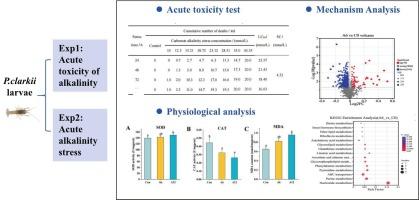Integrated untargeted metabolomics and physiological analysis reveal the response mechanisms of Procambarus clarkii larvae to carbonate alkalinity exposure
IF 4.3
3区 环境科学与生态学
Q2 BIOCHEMISTRY & MOLECULAR BIOLOGY
Comparative Biochemistry and Physiology C-toxicology & Pharmacology
Pub Date : 2025-08-11
DOI:10.1016/j.cbpc.2025.110327
引用次数: 0
Abstract
High alkalinity stress represents a critical yet understudied threat to aquatic organisms in saline-alkaline ecosystems. This study provides the first comprehensive investigation of carbonate alkalinity tolerance mechanisms in larval Procambarus clarkii, employing an innovative dual-approach methodology. Two experiments were conducted: the first aimed to determine the semi-lethal concentration (LC50) and safe concentration (SC) of alkalinity for larval P. clarkii, and the second to evaluate the physiological and biochemical enzyme activities and metabolic level under 96 h acute alkalinity stress. The LC50 alkalinity values of larval P. clarkii at 24, 48, 72, and 96 h were 25.57, 21.43, 18.40 and 16.03 mmol/L, respectively. The results of biochemical and physiological analyses showed that alkalinity stress disrupted oxidative immune balance, and physiological metabolism leading to increased superoxide dismutase (SOD), alkaline phosphatase (AKP), acid phosphatase (ACP), Na+-K+-ATPase, succinate dehydrogenase (SDH), glutamine synthetase (GS), glutamate dehydrogenase (GLDH), glutamic pyruvic transaminase (GPT) and glutamic oxalacetic transaminase (GOT) activities and malondialdehyde (MDA) contents and decreased catalase (CAT) and glycogen activities. Metabolomics analysis showed that in comparison with the control group, 414 (70 up- and 344 downregulated) and 675 (67 up- and 608 downregulated) significantly differential metabolites were identified in the A6 and A12 experimental groups, respectively. Our findings suggest that P. clarkii possess a certain level of tolerance to alkalinity stress; however, exposure to high alkalinity stress can adversely affect the antioxidant defense system, energy metabolism and immune response of crayfish. Our integrated approach provides a new framework for assessing crustacean resilience to saline-alkaline stress, with direct implications for aquaculture management under climate change scenarios.

综合非靶向代谢组学和生理分析揭示了克氏原螯虾(Procambarus clarkii)幼虫对碳酸盐碱性的反应机制。
高碱度胁迫是对盐碱生态系统中水生生物的一种严重威胁,但尚未得到充分研究。本研究首次采用创新的双方法对克氏原螯虾(Procambarus clarkii)幼虫的耐碳酸盐碱性机制进行了全面研究。试验分为两部分:一是测定碱性对克拉氏疟原虫幼虫的半致死浓度(LC50)和安全浓度(SC),二是测定96 h急性碱性胁迫下克拉氏疟原虫幼虫的生理生化酶活性和代谢水平。幼虫在24、48、72和96 h时的LC50碱度值分别为25.57、21.43、18.40和16.03 mmol/L。生化和生理分析结果表明,碱性胁迫破坏了氧化免疫平衡,生理代谢导致超氧化物歧化酶(SOD)、碱性磷酸酶(AKP)、酸性磷酸酶(ACP)、Na+-K+-ATPase、琥珀酸脱氢酶(SDH)、谷氨酰胺合成酶(GS)、谷氨酸脱氢酶(GLDH)和谷氨酸脱氢酶(GLDH)升高。谷丙转氨酶(GPT)和谷草转氨酶(GOT)活性和丙二醛(MDA)含量降低,过氧化氢酶(CAT)和糖原活性降低。代谢组学分析显示,与对照组相比,A6和A12实验组分别鉴定出414个(70个上调,344个下调)和675个(67个上调,608个下调)显著差异代谢物。研究结果表明,克氏杆菌对碱度胁迫具有一定的耐受性;然而,高碱度胁迫会对小龙虾的抗氧化防御系统、能量代谢和免疫反应产生不利影响。我们的综合方法为评估甲壳类动物对盐碱胁迫的适应能力提供了一个新的框架,对气候变化情景下的水产养殖管理具有直接意义。
本文章由计算机程序翻译,如有差异,请以英文原文为准。
求助全文
约1分钟内获得全文
求助全文
来源期刊
CiteScore
7.50
自引率
5.10%
发文量
206
审稿时长
30 days
期刊介绍:
Part C: Toxicology and Pharmacology. This journal is concerned with chemical and drug action at different levels of organization, biotransformation of xenobiotics, mechanisms of toxicity, including reactive oxygen species and carcinogenesis, endocrine disruptors, natural products chemistry, and signal transduction with a molecular approach to these fields.

 求助内容:
求助内容: 应助结果提醒方式:
应助结果提醒方式:


